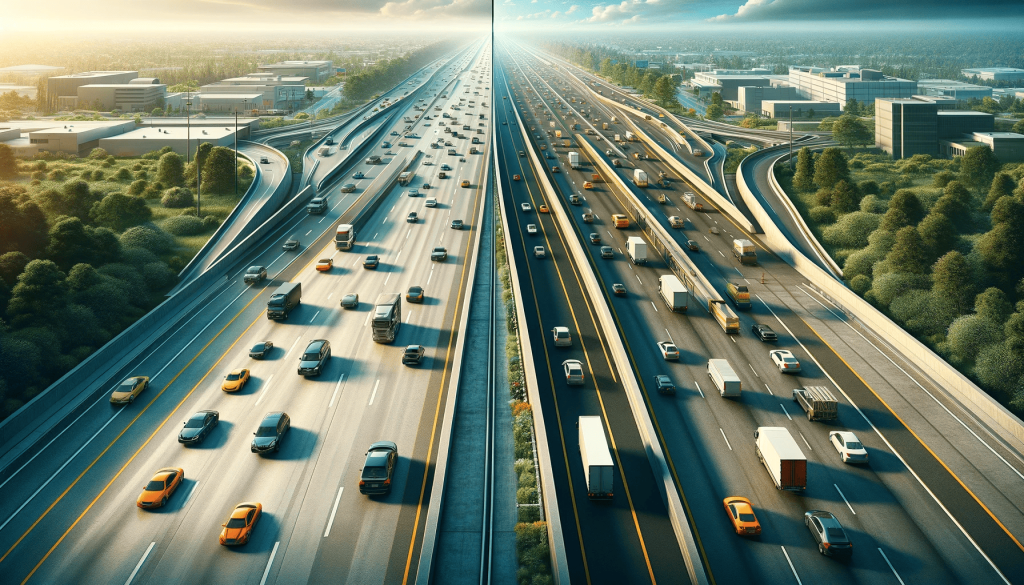What’s The Difference Between a Route and a Highway?
Freedom Heavy Haul can offer expedited Pickup and Delivery for any size shipment anywhere in the USA. Contact us today for No Hassle, No Pressure Pricing.
Understanding the differences between a route and a highway is crucial for travelers, city planners, and enthusiasts of road networks. This comprehensive guide aims to unravel these differences, exploring each concept in detail, and providing insights into their unique characteristics and purposes.
Difference Between a Route and a Highway
Road terminology can often be confusing, with terms like ‘routes’ and ‘highways’ used interchangeably. However, they have distinct meanings and implications in the context of transportation infrastructure.
Routes, Highways, and Knowing The Difference
A route is a general term for any road or path designated for travel by vehicles, while a highway refers specifically to major roads, usually connecting cities and regions. Highways are designed for faster travel and higher traffic volumes compared to conventional routes.
The Route
Routes play a crucial role in the transportation network, serving as the veins that connect various parts of a community or region. Their versatility is seen in the variety of forms they take, from quaint local roads winding through neighborhoods to larger state or national roads that bind different regions together. Unlike highways, routes are characterized by their integration into the local landscape, often meandering through the heart of communities.

Key characteristics of routes include:
- Diverse Range: Spanning from narrow, single-lane roads in rural areas to broader roads in urban settings.
- Multiple Stops: Featuring frequent stop signs, traffic lights, and pedestrian crossings, catering to local traffic needs.
- Lower Speed Limits: Due to their proximity to residential areas and frequent stops, routes have lower speed limits for safety.
- Direct Access: Routes provide direct access to homes, businesses, and other local destinations.
- Scenic Value: Often offering more scenic drives through towns, countryside, or historic areas.
The Highway
Highways are the backbone of long-distance transportation, designed to facilitate efficient and fast travel over great distances. These roads are engineered to support high volumes of traffic at high speeds, connecting cities, states, and even spanning across national borders. Highways reduce travel time significantly and are a key component in the movement of goods and people across vast distances.

Distinctive features of highways include:
- Multi-Lane Roads: Highways often have multiple lanes in each direction to accommodate heavy traffic.
- High Speed Limits: Designed for speed, they have higher speed limits than routes.
- Limited Access Points: Entry and exit are typically controlled through ramps, reducing traffic disruptions.
- Minimal Intersections: Overpasses and underpasses are used to avoid cross traffic, which helps in maintaining a constant flow.
- Long-Distance Travel: Highways are ideal for long-distance travel, bypassing local traffic and towns.
Distinguishing Between Highways and Routes
The primary distinction lies in their purpose and design. Highways are for swift, long-distance travel, while routes serve more localized or diverse transportation needs.
The Advantages of Routes Over Highways
Routes offer more scenic and diverse journeys, often connecting smaller towns and offering more direct access to various locations within cities.
Why Highways are Preferred Over Routes
Highways are preferred for their efficiency in time-saving and facilitating the movement of large volumes of traffic over long distances.
How To Choose The Most Suitable Road for Your Journey
The choice depends on the destination, the desired speed of travel, and the preference for scenic value versus efficiency.
American Road Nomenclature: What are roads called in the USA?
The United States boasts a vast and intricate network of roads, each category distinguished by unique naming conventions that reflect their purpose and scale. This network is a critical infrastructure component, ensuring the smooth flow of traffic across the country, from the bustling cities to the serene countryside.
The American Highway System: A Closer Look
The U.S. highway system is a complex and expansive network, including:
- Interstate Highways: These are major highways that span across state lines, designed for high-speed, long-distance travel. For example, Interstate 10 (I-10) stretches from California to Florida, crossing multiple states.
- U.S. Routes: These are a network of roads that also traverse state boundaries but are older and sometimes less direct than the interstates. An iconic example is Route 66, which historically ran from Chicago, Illinois, to Santa Monica, California.
- State Routes: These roads are confined within individual states, addressing regional and local transportation needs. For instance, California State Route 1 (SR 1), also known as the Pacific Coast Highway, runs along most of the California coastline.
Route Naming Conventions in the United States
U.S. Routes and State Routes, integral parts of the American road system, have their unique naming and numbering schemes:
- U.S. Routes: Often marked with a U.S. shield and a number, these routes crisscross the country. For example, U.S. Route 1 runs along the East Coast, connecting major cities from Maine to Florida.
- State Routes: Each state has its system of naming and numbering routes, often indicated with a unique state-specific shield. For example, Texas State Highway 35 (SH 35) runs along a portion of the Texas Gulf Coast.
These routes, with their distinctive numbers and paths, weave through the American landscape, providing essential connectivity and reflecting the diverse transportation needs across the nation.
Comparing Highways and Expressways: What’s the Difference?
While highways and expressways are similar, there are subtle differences, primarily in access control and design.

Expressways vs Highways: Understanding the Nuances
Expressways are a type of highway with controlled access, typically without intersections, favoring overpasses and underpasses for connectivity.
Exploring Unusual Road Systems: Hawaii’s Interstate Highway
Hawaii’s interstate highway system is unique, considering the state’s geographical isolation.
Why Hawaii Has an Interstate Highway Despite Its Geography
Funded by the same federal program as continental interstates, Hawaii’s highways serve a similar purpose of connecting major regions, albeit within the island’s geography.
The Role of Stoplights in Freeway Systems
Understanding the role of stoplights in freeway systems can be critical in assessing their efficiency and safety.
Do Freeways Have Stoplights? Debunking Common Myths
Generally, freeways, a subset of highways, do not have stoplights. Their design is focused on free-flowing traffic, utilizing ramps for entries and exits.
International Road Systems: A Comparative Perspective
Examining road systems globally provides a broader understanding of how different countries manage their transportation infrastructure.
Why Canada Lacks an Interstate System: An Analysis
Unlike the United States, Canada does not have an interstate system. Instead, it has a series of Trans-Canada Highways and Provincial Highways, serving similar purposes.
Global Road Systems: How Other Countries Structure Their Highways and Routes
Each country has its unique approach to road systems, influenced by geography, economics, and cultural factors.
Historical Evolution of Road Systems
The history of road development offers insights into how modern transportation networks have evolved.
The Evolution of the Modern Highway: A Historical Perspective
The development of highways has been a progressive journey, from simple dirt paths to complex, multi-lane roads facilitating global trade and travel.
Route Development Through the Ages
Routes have also transformed, evolving from footpaths and trails into paved roads that form the backbone of local and regional travel.
Technological Advancements in Road Infrastructure
Technological advancements have significantly influenced the development and maintenance of road infrastructure.
Innovations in Highway Construction and Maintenance
Modern highways incorporate advanced materials and technologies for durability and sustainability.
Emerging Technologies in Route Navigation and Safety
GPS and digital mapping have revolutionized route navigation, while safety features like smart traffic signals have enhanced road safety.
Environmental Impact of Road Networks
The environmental impact of road networks is an increasingly important consideration in their planning and development.
Assessing the Environmental Footprint of Highways
Highways, with their extensive coverage, have significant environmental impacts, influencing land use and wildlife.
Routes and Environmental Sustainability: Challenges and Solutions
Routes, especially in urban areas, present both challenges and opportunities for sustainable development, affecting local ecosystems and urban planning.







